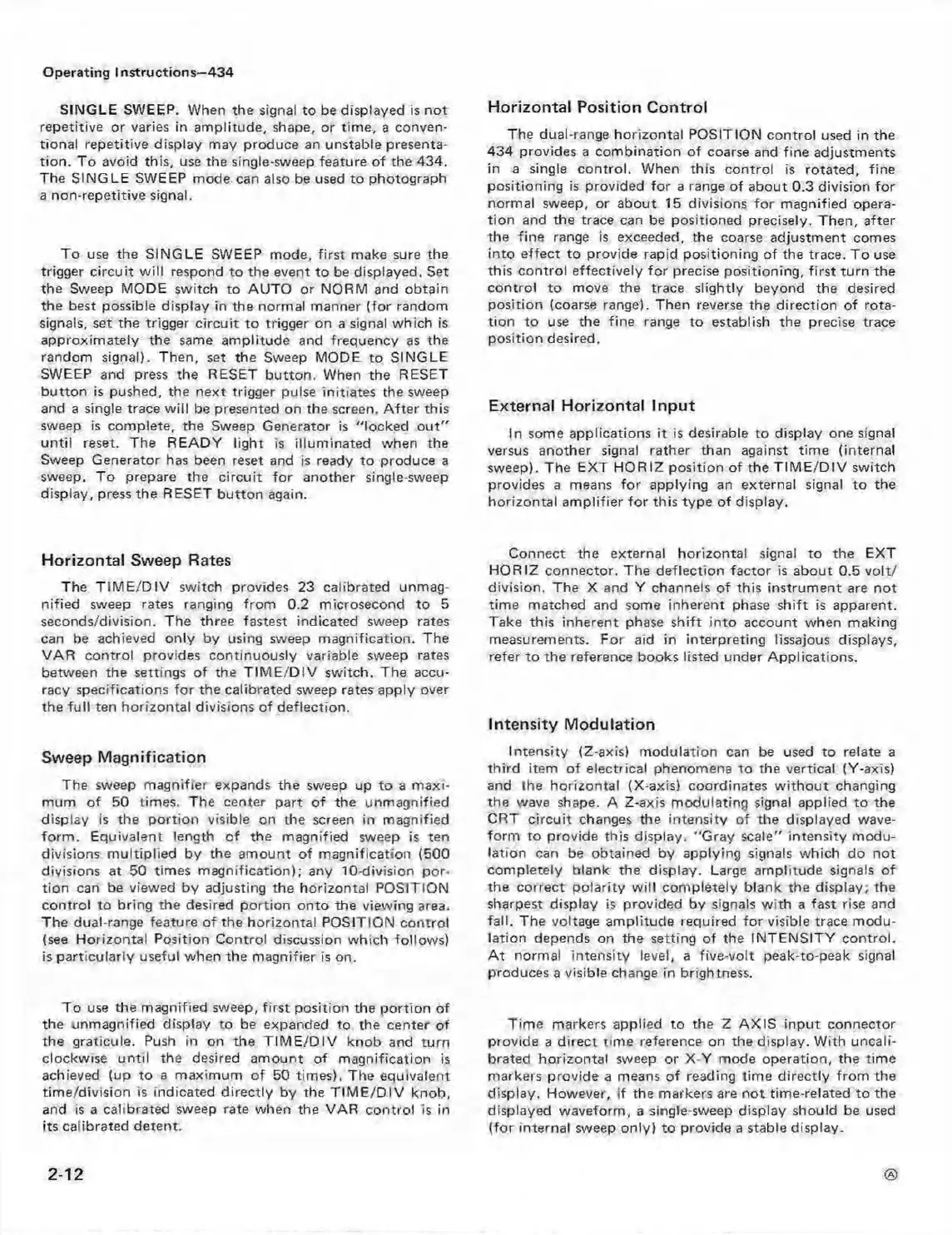Operating Instructions—434
SINGLE SWEEP. When the signal to be displayed is not
repetitive or varies in amplitude, shape, or time, a conven
tional repetitive display may produce an unstable presenta
tion. To avoid this, use the single-sweep feature of the 434.
The SINGLE SWEEP mode can also be used to photograph
a non-repetitive signal.
To use the SINGLE SWEEP mode, first make sure the
trigger circuit w ill respond to the event to be displayed. Set
the Sweep MODE switch to AUTO or NORM and obtain
the best possible display in the normal manner (for random
signals, set the trigger circuit to trigger on a signal which is
approximately the same amplitude and frequency as the
random signal). Then, set the Sweep MODE to SINGLE
SWEEP and press the RESET button. When the RESET
button is pushed, the next trigger pulse initiates the sweep
and a single trace w ill be presented on the screen. A fte r this
sweep is complete, the Sweep Generator is "locked ou t"
until reset. The READY light is illuminated when the
Sweep Generator has been reset and is ready to produce a
sweep. To prepare the circuit for another single-sweep
display, press the RESET button again.
Horizontal Sweep Rates
The T IM E /D IV switch provides 23 calibrated unmag
nified sweep rates ranging from 0.2 microsecond to 5
seconds/division. The three fastest indicated sweep rates
can be achieved only by using sweep magnification. The
VAR control provides continuously variable sweep rates
between the settings of the TIM E /D IV switch. The accu
racy specifications for the calibrated sweep rates apply over
the fu ll ten horizontal divisions of deflection.
Sweep Magnification
The sweep magnifier expands the sweep up to a maxi
mum of 50 times. The center part of the unmagnified
display is the portion visible on the screen in magnified
form . Equivalent length of the magnified sweep is ten
divisions multiplied by the amount of magnification (500
divisions at 50 times magnification); any 10-division por
tion can be viewed by adjusting the horizontal POSITION
control to bring the desired portion onto the viewing area.
The dual-range feature of the horizontal POSITION control
(see Horizontal Position Control discussion which follows)
is particularly useful when the magnifier is on.
To use the magnified sweep, first position the portion of
the unmagnified display to be expanded to the center of
the graticule. Push in on the T IM E/D IV knob and turn
clockwise until the desired amount of magnification is
achieved (up to a maximum of 50 times). The equivalent
time/division is indicated directly by the T IM E /D IV knob,
and is a calibrated sweep rate when the VAR control is in
its calibrated detent.
Horizontal Position Control
The dual-range horizontal POSITION control used in the
434 provides a com bination of coarse and fine adjustments
in a single control. When this control is rotated, fine
positioning is provided for a range of about 0.3 division fo r
normal sweep, or about 15 divisions fo r magnified opera
tion and the trace can be positioned precisely. Then, after
the fine range is exceeded, the coarse adjustment comes
into effect to provide rapid positioning of the trace. To use
this control effectively for precise positioning, first turn the
control to move the trace slightly beyond the desired
position (coarse range). Then reverse the direction of rota
tion to use the fine range to establish the precise trace
position desired.
External Horizontal Input
In some applications it is desirable to display one signal
versus another signal rather than against time (internal
sweep). The EXT HORIZ position of the T IM E /D IV switch
provides a means for applying an external signal to the
horizontal amplifier for this type of display.
Connect the external horizontal signal to the EXT
HORIZ connector. The deflection factor is about 0.5 vo lt/
division. The X and Y channels of this instrum ent are not
tim e matched and some inherent phase shift is apparent.
Take this inherent phase shift into account when making
measurements. For aid in interpreting lissajous displays,
refer to the reference books listed under Applications.
Intensity Modulation
Intensity (Z-axis) modulation can be used to relate a
third item of electrical phenomena to the vertical (Y-axis)
and the horizontal (X-axis) coordinates w itho ut changing
the wave shape. A Z-axis modulating signal applied to the
CRT circuit changes the intensity of the displayed wave
form to provide this display. "Gray scale" intensity modu
lation can be obtained by applying signals which do not
completely blank the display. Large amplitude signals of
the correct polarity will completely blank the display; the
sharpest display is provided by signals w ith a fast rise and
fall. The voltage amplitude required for visible trace m odu
lation depends on the setting of the INTENSITY control.
A t normal intensity level, a five-volt peak-to-peak signal
produces a visible change in brightness.
Time markers applied to the Z AXIS input connector
provide a direct time reference on the display. W ith uncali
brated horizontal sweep or X-Y mode operation, the time
markers provide a means of reading time directly from the
display. However, if the markers are not time-related to the
displayed waveform, a single-sweep display should be used
(for internal sweep only) to provide a stable display.
©
2-12

